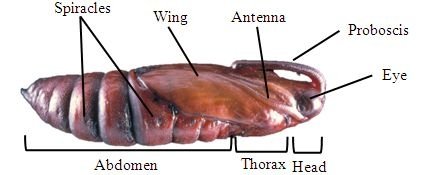
If you’re new to the world of insects, hornworms are the larval stage of the hawk moth. You might have encountered them in gardens, where they can be a bit of a nuisance to plants. However, the transformation they undergo is one of nature’s coolest tricks. The pupation process is crucial for their lifecycle, but it can raise a few questions. For instance, why do they go underground, and what exactly happens during this stage? Let’s break it down.
What is Pupation?
Pupation is a fascinating stage in an insect’s life cycle. Think of it as the ultimate makeover. Just like a caterpillar turns into a butterfly, hornworms undergo a complete transformation during pupation. This process is part of their metamorphosis, where they change from a larval stage into an adult form. It’s not just a simple change of clothes; it’s a whole new identity.
During pupation, hornworms enter a protective casing called a pupa, or chrysalis. This stage can last anywhere from a few days to weeks, depending on environmental factors like temperature and humidity. Inside this cocoon, their body breaks down and reorganizes into the structure of a moth. It’s like a caterpillar cooking up a brand-new version of itself in a cozy little restaurant underground.
Why Do Hornworms Go Underground to Pupate?
You might be wondering why hornworms choose to burrow underground for their pupation. First and foremost, it’s a survival tactic. Going underground helps shield them from predators like birds and other insects that might snag a quick meal just as they’re about to change. It’s like going off the grid for a while—keeping a low profile until they’re ready for their grand debut.
Additionally, the ground provides a more stable environment. It regulates temperature and humidity, which are critical for the pupating hornworm. If they stayed above ground, they could face harsh conditions that might disrupt their transformation, similar to how we struggle to relax in a noisy coffee shop.
What Happens Underground During Pupation?
Once the hornworm has found a cozy spot to bury itself, the real magic happens. Inside its pupa, the hornworm’s body breaks down its old cells and begins to reconfigure itself. This isn’t just a simple switch; it’s a complex process that involves many biological systems rearranging and forming new structures.
During this time, the hornworm is completely vulnerable, but it’s also where the real change occurs. The tissues and organs start to form wings, legs, and other adult features. Imagine being wrapped in a cozy blanket, while all the hard work is done behind the scenes to create something beautiful!
The Duration of Pupation
You might be curious about how long hornworms stay in this pupation stage. Generally, they stay underground for about seven to fourteen days, though this can vary based on their species and environmental factors. Warmer temperatures usually speed up the process, while cooler conditions can delay it.
Also, during this time, they’re not eating. Instead, they tap into reserves they built up while munching on leaves. It’s like going into an extended retreat, where they focus solely on transformation without any distractions.
Identifying Hornworm Pupae
If you’re a gardener or just someone interested in nature, you might want to know what hornworm pupae look like. They often resemble small, leathery cocoons. Depending on the species, they can be brown, green, or even a grayish color, blending in beautifully with the soil around them.
If you’re curious enough to dig up a few, make sure to handle them gently. Disturbing the pupae could interrupt this crucial stage of their lifecycle, and we wouldn’t want to spoil the surprise of their emergence!
What Happens After Pupation?
After the pupation period is over, the hornworm will emerge as an adult moth. This is the moment they’ve been preparing for. It’s kind of like a reunion party after being away for a while. They’ll need some time to pump their wings full of blood before taking flight, but once they do, they’ll be ready to start the cycle all over again by laying eggs.
The transformation isn’t just a new look; it’s a new phase of life. Adult moths typically live for a few weeks, during which they’ll mate and lay eggs, leading to the next generation of hornworms. This cycle keeps going, reminding us how nature has a way of renewing itself.
Hornworm pupation is a remarkable process that showcases the wonders of nature. From their underground hideouts to the stunning transformation they undergo, these little creatures remind us that change is a part of life. While they may be a gardener’s nightmare at times, their journey from hornworm to moth is nothing short of incredible.
So next time you spot a hornworm munching away in your garden, remember that underneath the soil, they’re busy preparing for something extraordinary. Isn’t nature amazing? Whether you’re an avid gardener or just curious about the world around you, understanding hornworm pupation adds another layer of appreciation for these fascinating insects and the cycles of life they embody.
